‘Cool streets’: How Vienna is preparing for climate change and heatwaves
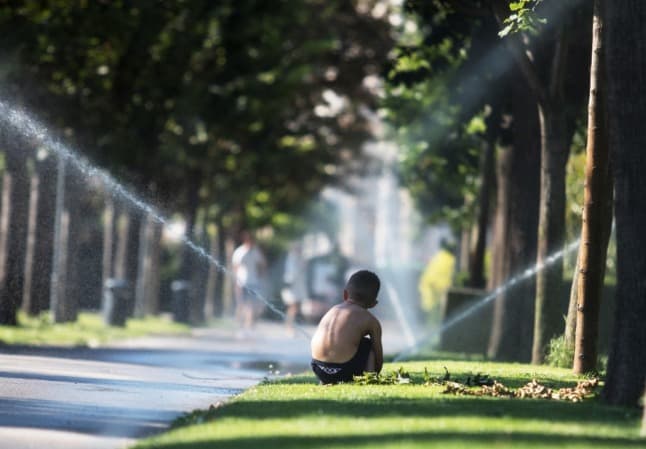
Summers in Vienna are getting hotter, with the temperatures regularly rising above 30 or even 35 degrees. What can Vienna do to make the city more liveable?
Climate change has made the world's cities hotter - and Vienna is no exception.
The capital recorded its hottest year in 2017, with 33 days on which maximum daily temperatures of over 30 degrees Celsius were measured.
And while between 1961 and 1990, Vienna experienced an average of 9.6 hot days a year, from 1981 to 2010 this increased to an average of 15.2 hot days per year. In 2019 there were already 12 hot days by June. It is forecast that by 2050, Vienna could be up to 8 degrees warmer.
Many people in the city live in older apartments, with no air conditioning, or work in old buildings which are not adapted to the heat of the 21st Century.
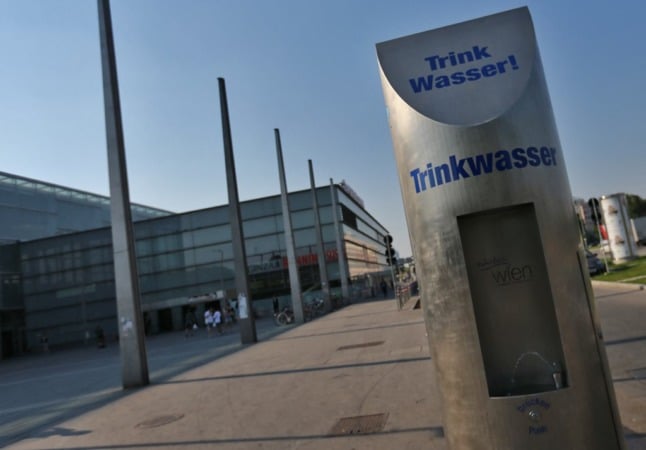
One of the drinking water fountains installed for the summer across Vienna. (Photo by ALEXANDER KLEIN / AFP)
Heat inequality
While more than 50 percent of Vienna is made up of green spaces, it is unequally distributed, with residents living in poorer, inner-city neighbourhoods benefiting from less access to green spaces than the more well-off or suburban Viennese.
Many built-up areas in Vienna can become “heat islands” due to the lack of greenery and the concrete landscape intensifying summer heat by as much as five degrees, which can be seen on the city’s heat map.
So what is the city doing to combat the ever-hotter summers?
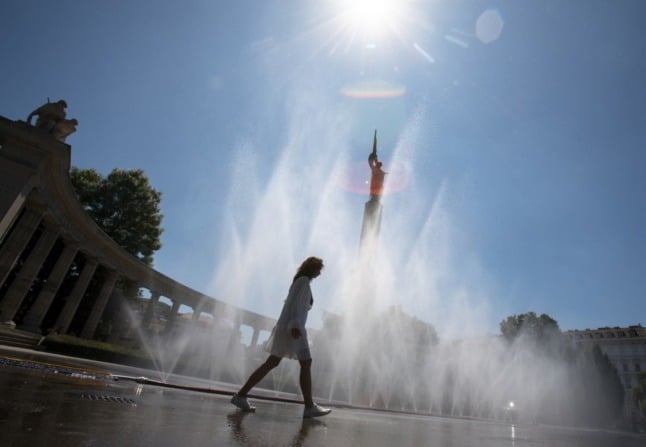
A woman walks past water sprayed from a pipe at the Schwarzenberg square. (Photo by ALEX HALADA / AFP)
Fog showers
Since 2019, the city has been installing fog showers, known as Brunnhildes around the city, which spray a fine mist into the air to cool down passers-by.
The Kurier reports a total of 260 Brunnhildes, mist showers ("summer splashes") and water sprays were set up in Vienna this summer. Tap water from fountains can be obtained free of charge at 1,100 tapping points. On particularly hot days, a water curtain is switched on at Karlsplatz, with the name "Karlsplatsch".
The water features in Vienna's parks have also been expanded, and five new playgrounds in the Lichtentalerpark and in the Wanda-Lanzer-Park added to the 111 in the city with water play.
15 minute city
Vienna has also adopted the idea of the 15-minute city concept, according to Der Standard newspaper, which is also being experimented with in cities such as Oslo and Berlin.
It means the most important everyday routes can be reached within a 15-minute walk: supermarket, bakery, restaurant, doctor, pharmacy, flower shop, kindergarten, school, authorities, U-Bahn station as well as sports facilities and recreational areas. It creates a small village atmosphere within a big city.
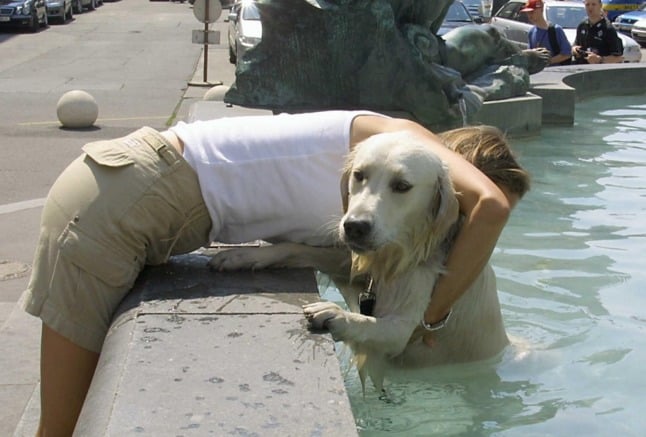 A tourist bathes her Labrador in the Neuer Markt fountain in Vienna. (Photo by BORIS HORVAT / AFP)
A tourist bathes her Labrador in the Neuer Markt fountain in Vienna. (Photo by BORIS HORVAT / AFP)
To help people cool down in their "village", Vienna has also created a goal to create greenery all over the city, planting more trees and small gardens, with the aim of having some kind of green space every 250 metres, even if it is just a small patch of earth with some flowers and a tree planted in it.
Car-free streets
Another initiative to make the city more liveable is removing cars from a number of the city's streets and squares.
However, although Vienna has been somewhat successful in implementing these measures, it is seen to be lagging behind cities such as Paris in getting people out of their cars in grand schemes, such as pedestrianising the Avenue des Champs-Élysées, or creating traffic free zones and cycle lanes throughout the city.
Although the city experimented with car free streets (called Coolen Straßen) in 2019, and also tried out new bike lanes through the city last year, these have been quietly dropped, the Kurier newspaper reports. The bike lane was on occasion strewn with tacks by irritated drivers and the “cool streets” banning cars did not prove as popular as hoped.
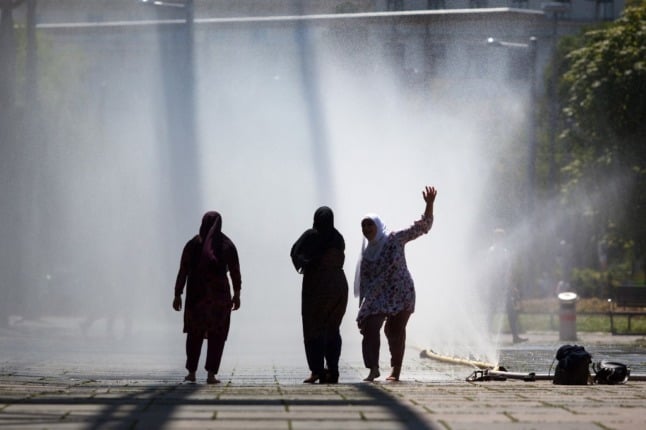
Woman walk past water sprayed from a pipe at Praterstern Square in Vienna (Photo by ALEX HALADA / AFP)
The new “Cool Streets plus (Coolen Straßen Plus”) scheme in Phorusgasse (4th), Pelzgasse (15th), Goldschlagstraße (14th) and Franklinstraße (21st) will mean these roads will be planted with trees, surfaced with lighter asphalt, and shade or water elements.
However, there will be no driving, stopping or parking ban in these new “cool streets”, although traffic calming will be in place.
Where have cars been banned in Vienna?
A number of streets in Vienna have now been made largely free of cars, including: Mariahilfe Strasse, Herrengasse, LangeGasse, Otto Otto-Bauer-Gasse, Rotenturmstrasse and Neubaugasse. And in new districts of Vienna such as the Nordbahnhof, Sonnwendviertel or Seestadt Aspern, people are being discouraged from using their cars through measures such as limited parking and 30km hour zones.
However, writing in the Leben in Wien magazine in 2020, journalist Wojciech Czaja, said Vienna “with its strong motorist lobby and around 400,000 parking spaces” was still a “long way” from Paris’s ambitious scheme to get people out of their cars and onto public transport and bicycles.
And traffic expert Angelika Rauch said, in an interview with Czaja in Der Standard in 2020, that she feared Vienna would fall behind Paris in its "liveability" ratings, due to the French city's "radical plans" to rid the city of cars and make it easier for cyclists to travel around the city.
Comments
See Also
Climate change has made the world's cities hotter - and Vienna is no exception.
The capital recorded its hottest year in 2017, with 33 days on which maximum daily temperatures of over 30 degrees Celsius were measured.
And while between 1961 and 1990, Vienna experienced an average of 9.6 hot days a year, from 1981 to 2010 this increased to an average of 15.2 hot days per year. In 2019 there were already 12 hot days by June. It is forecast that by 2050, Vienna could be up to 8 degrees warmer.
Many people in the city live in older apartments, with no air conditioning, or work in old buildings which are not adapted to the heat of the 21st Century.

While more than 50 percent of Vienna is made up of green spaces, it is unequally distributed, with residents living in poorer, inner-city neighbourhoods benefiting from less access to green spaces than the more well-off or suburban Viennese.
Many built-up areas in Vienna can become “heat islands” due to the lack of greenery and the concrete landscape intensifying summer heat by as much as five degrees, which can be seen on the city’s heat map.
So what is the city doing to combat the ever-hotter summers?

Fog showers
Since 2019, the city has been installing fog showers, known as Brunnhildes around the city, which spray a fine mist into the air to cool down passers-by.
The Kurier reports a total of 260 Brunnhildes, mist showers ("summer splashes") and water sprays were set up in Vienna this summer. Tap water from fountains can be obtained free of charge at 1,100 tapping points. On particularly hot days, a water curtain is switched on at Karlsplatz, with the name "Karlsplatsch".
The water features in Vienna's parks have also been expanded, and five new playgrounds in the Lichtentalerpark and in the Wanda-Lanzer-Park added to the 111 in the city with water play.
15 minute city
Vienna has also adopted the idea of the 15-minute city concept, according to Der Standard newspaper, which is also being experimented with in cities such as Oslo and Berlin.
It means the most important everyday routes can be reached within a 15-minute walk: supermarket, bakery, restaurant, doctor, pharmacy, flower shop, kindergarten, school, authorities, U-Bahn station as well as sports facilities and recreational areas. It creates a small village atmosphere within a big city.

To help people cool down in their "village", Vienna has also created a goal to create greenery all over the city, planting more trees and small gardens, with the aim of having some kind of green space every 250 metres, even if it is just a small patch of earth with some flowers and a tree planted in it.
Car-free streets
Another initiative to make the city more liveable is removing cars from a number of the city's streets and squares.
However, although Vienna has been somewhat successful in implementing these measures, it is seen to be lagging behind cities such as Paris in getting people out of their cars in grand schemes, such as pedestrianising the Avenue des Champs-Élysées, or creating traffic free zones and cycle lanes throughout the city.
Although the city experimented with car free streets (called Coolen Straßen) in 2019, and also tried out new bike lanes through the city last year, these have been quietly dropped, the Kurier newspaper reports. The bike lane was on occasion strewn with tacks by irritated drivers and the “cool streets” banning cars did not prove as popular as hoped.

The new “Cool Streets plus (Coolen Straßen Plus”) scheme in Phorusgasse (4th), Pelzgasse (15th), Goldschlagstraße (14th) and Franklinstraße (21st) will mean these roads will be planted with trees, surfaced with lighter asphalt, and shade or water elements.
However, there will be no driving, stopping or parking ban in these new “cool streets”, although traffic calming will be in place.
Where have cars been banned in Vienna?
A number of streets in Vienna have now been made largely free of cars, including: Mariahilfe Strasse, Herrengasse, LangeGasse, Otto Otto-Bauer-Gasse, Rotenturmstrasse and Neubaugasse. And in new districts of Vienna such as the Nordbahnhof, Sonnwendviertel or Seestadt Aspern, people are being discouraged from using their cars through measures such as limited parking and 30km hour zones.
However, writing in the Leben in Wien magazine in 2020, journalist Wojciech Czaja, said Vienna “with its strong motorist lobby and around 400,000 parking spaces” was still a “long way” from Paris’s ambitious scheme to get people out of their cars and onto public transport and bicycles.
And traffic expert Angelika Rauch said, in an interview with Czaja in Der Standard in 2020, that she feared Vienna would fall behind Paris in its "liveability" ratings, due to the French city's "radical plans" to rid the city of cars and make it easier for cyclists to travel around the city.
Join the conversation in our comments section below. Share your own views and experience and if you have a question or suggestion for our journalists then email us at [email protected].
Please keep comments civil, constructive and on topic – and make sure to read our terms of use before getting involved.
Please log in here to leave a comment.